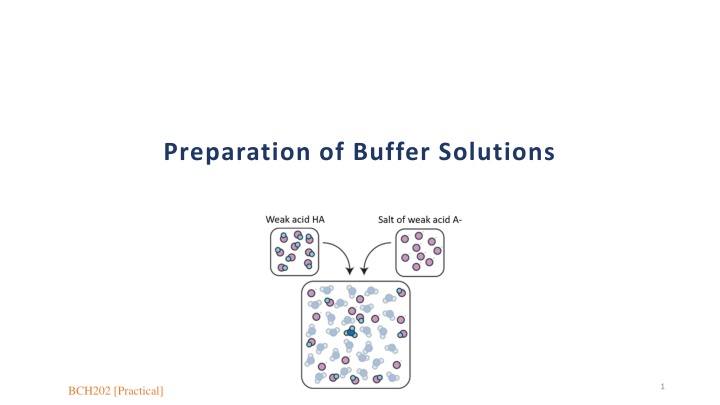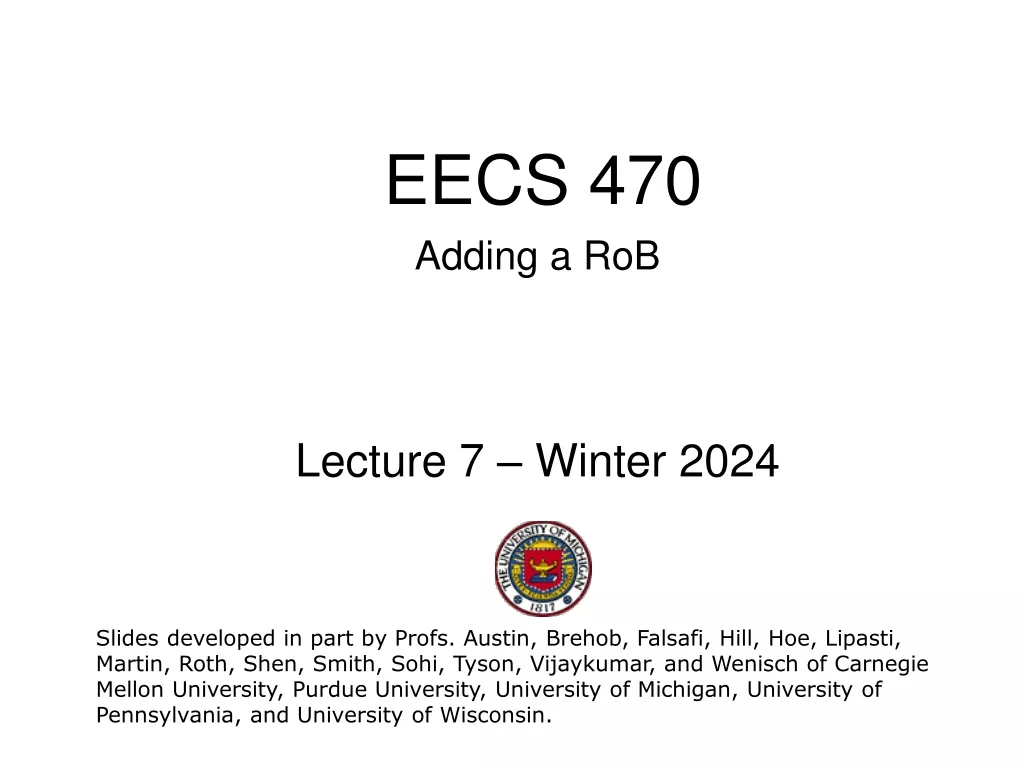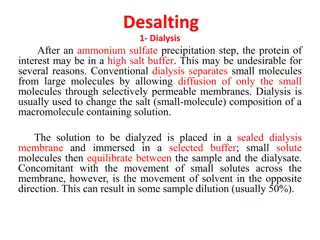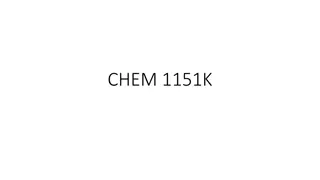Buffer Solutions in Biochemical Systems: pH and Buffers
The acidity and basicity of solutions are determined by pH, a measure of hydrogen ion concentration. Buffers resist pH changes in biological reactions by maintaining balance between hydrogen and hydroxide ions, utilizing weak acids or bases and their salts.
Download Presentation

Please find below an Image/Link to download the presentation.
The content on the website is provided AS IS for your information and personal use only. It may not be sold, licensed, or shared on other websites without obtaining consent from the author.If you encounter any issues during the download, it is possible that the publisher has removed the file from their server.
You are allowed to download the files provided on this website for personal or commercial use, subject to the condition that they are used lawfully. All files are the property of their respective owners.
The content on the website is provided AS IS for your information and personal use only. It may not be sold, licensed, or shared on other websites without obtaining consent from the author.
E N D
Presentation Transcript
Preparation of Buffer Solutions 1 BCH202 [Practical]
Hydrogen number (pH) : The acidity and basicity of certain solutions can be determined by measuring hydrogen number (pH). pH defined as: The negative logarithm of the hydrogen ion concentration. pH= - Log [H+] When the pH value is high, it mean the concentration of hydrogen ion is low and vice versa. 2
Acidic medium: Acidic medium: The hydrogen ion is present in a very large amount (or high concentration), exceeding that of hydroxide. Neutral medium: The hydrogen and hydroxide ions are present in equal amounts (or equal concentrations). Basic medium: The hydrogen ion is present in very low amounts (or low concentration), less than that of hydroxide 3
Measuring of hydrogen number: To measure the hydrogen number in certain solution in very accurate way, we use a special instrument called pH meter. It s consisted of glass electrode which contain a very thin bulb, blown onto a hard glass tube which is sensitive to pH. The bulb contains a solution of hydrochloric acid and is connected to a platinum lead via silver -silver chloride electrode which is reversible with respect to hydrogen ions. 4
Other method to know the pH of the medium is by using Test strips. Supporting materials: 1. How pH meter works: https://youtu.be/P1wRXTl2L3I 2. How to use the pH meter: https://youtu.be/vwY-xWMam7o 5
pH and biological system: All biochemical reactions occur under strict conditions of the concentration of hydrogen ion. So how to resist changes in pH ? Buffers. 6
Buffers: So, buffers defines as: the solutions that have the ability to resist changes in pH upon the addition of limited amounts of acid or base. A buffer is made up of : 1- a weak acid and its conjugate base (salt of the weak acid). Or 2- a weak base and its conjugate acid (salt of the weak base). So, the buffers are tow types. 7
Two types of Buffers Basic Buffer Acidic Buffer Are made from weak acid and its conjugated base[ its salt]. Are made from weak base and its conjugated acid [ its salt]. Example: Example: [CH3COOH / CH3COONa] buffer made of: CH3COOH (Weak acid) CH3COONa (conjugated base its salt-) [NH3 / NH4Cl ] buffer made of: NH3 (Weak base) NH4Cl (conjugated acid its salt-) 8
Mechanism of action: (How buffers can resist the change in pH?) -Example using [HA/A-] buffer:Where: HA is Weak acid and A- is conjugated base [its salt]. States A: If H+ (acid) is added to this buffer system H+will react with conjugated base (or the salt of weak acid A- ) to give conjugate acid [HA]. H+ A- HA 9
If OH-(base) is added to this buffer system OH- will react with conjugated acid to give conjugate base and H2O. OH- HA A- + H2O 10
NOTE: the buffer resists pH changes, when its two components are present in specific proportions. Thus, a buffer can protect against pH changes from added H+ or OH- ion as long as there is sufficient basic and acidic forms respectively As soon as you run out of one of the forms you no longer have a buffer . 11
Mechanism of Action cont Example: Buffer system: CH3COOH / CH3COO- , (CH3COOH :acid - CH3COO-: conjugated base ) -When acid [H+] added: CH3COO- + H+ CH3COOH -When base [OH] added: CH3COOH + OH - CH3COO- + H2O 12
Henderson-Hasselbalch equation: The Henderson-Hasselbalch equation is an equation that is often used to: 1- To calculate the pH of the Buffer. 2-To prepare Buffer. Where: - **pH**: is the hydrogen number. - **pKa**: is the acid dissociation constant. - **[A ]**: is the concentration of the conjugate base (salt). - **[HA]**: is the concentration of the acid."
Buffer capacity: It expresses the efficiency of the buffer solution in resisting changes in pH. Buffer capacity can be defined in many ways, it can be defined as: The number of moles of H+/OH- ions that must be added to one liter of the buffer in order to decrease /increase the pH by one unit respectively. Buffer capacity is directly proportional to the buffer concentration. How?
Objectives: To learn how to prepare buffers: A. Preparation of phosphate buffer: To understand the behaviour of buffers solutions.
A. Preparation of phosphate buffer: Prepare 50 ml from phosphate buffer with concentration 0.25M and pH=7.4, if you know that (pKa=7.2). You are provided with buffer solution content: (Monosodium dihydrogen phosphate NaH2PO4 )and (Disodium hydrogen phosphate Na2HPO4.) Solution: Provided: Pka = 7.2 pH=7.4 Final volume of buffer =50 ml Concentration of buffer = 0.25 M [HA] + [A-] Required: Weight in grams (g) of NaH2PO4 (as HA) and Na2HPO4 (as A-). 50 ml
Calculations: -To prepare a buffer Henderson-Hasselbalch equation is used: pH = pka + log [A-] \[HA] First: calculate the concentration of the weak acid and its conjugated base that make up the buffer with 0.25 M: Assume [A-] = y and [HA] = 0.25 y
So: ? 7.4 = 7.2 + log 0.25 ? ? 0.25 ? 0.2=log By taking the Anti log for both sides : ? 1.58 = y=0.395 1.58 y 1.58 y + y = 0.395 0.25 ? y= 0.15 M [which is the concentration of [A-] in the buffer ] 0.15+ 0.1 = 0.25M So, [HA] = 0.25 0.15 = 0.1 M [which is the concentration of [HA] in the buffer ] Which is the targeted concentration 19
Second: Calculate the weight in grams (g) needed from [A-] and [HA] using Molarity: A. Calculate the weight in (g) needed from [A-] to prepare the buffer, so number of mole of [A- ] should be calculated first : Calculate moles of A- in buffer: No. of mole (of A-) = molarity [A-] X volume in Liter (volume of the buffer) = 0.15 M x 0.05 L = 0.0075 mole Calculate weight of [A-] needed: Weight in (g) of [A-] = No. of moles x M.W. (g/mole) = 0.0075 x 142 = 1.065 g -------------------------------------------------------------------------------------------------------------------------------------- B. Calculate the weight in (g) needed from [HA] to prepare the buffer, so number of mole of [HA] should be calculated first : Calculate moles of HA in buffer: No. of mole (of HA) = molarity [HA] X volume L (volume of the buffer) = 0.1 M x 0.05 L = 0.005 mole Calculate weight of [HA] needed: Weight in (g) of [HA] = No. of moles x M.W. (g/mole) = 0.005 x 120 = 0.6 g
Method: Now take 0.6 g from NaH2PO4 and 1.065 g from Na2HPO4 dissolve them in a volume of a distal water (less than 50 ml). Check the pH, then complete the volume up to 50 ml by addition of distal water using a volumetric flask.
B. Testing for buffering behavior: Method: 1. In one beaker add 10 ml of 0.25M phosphate buffer that you have prepared, and in another beaker add 10 ml of KCl. 2. Measure the pH. 3. Add 0.1 ml from 2 M HCl to both solutions. 4. Measure the pH after the addition. 5. Record your observation. And discuss the result. Solution Measured pH Add 2M HCl Measured pH 0.25M Phosphate buffer 0.1 ml o.2M KCl 0.1 ml























